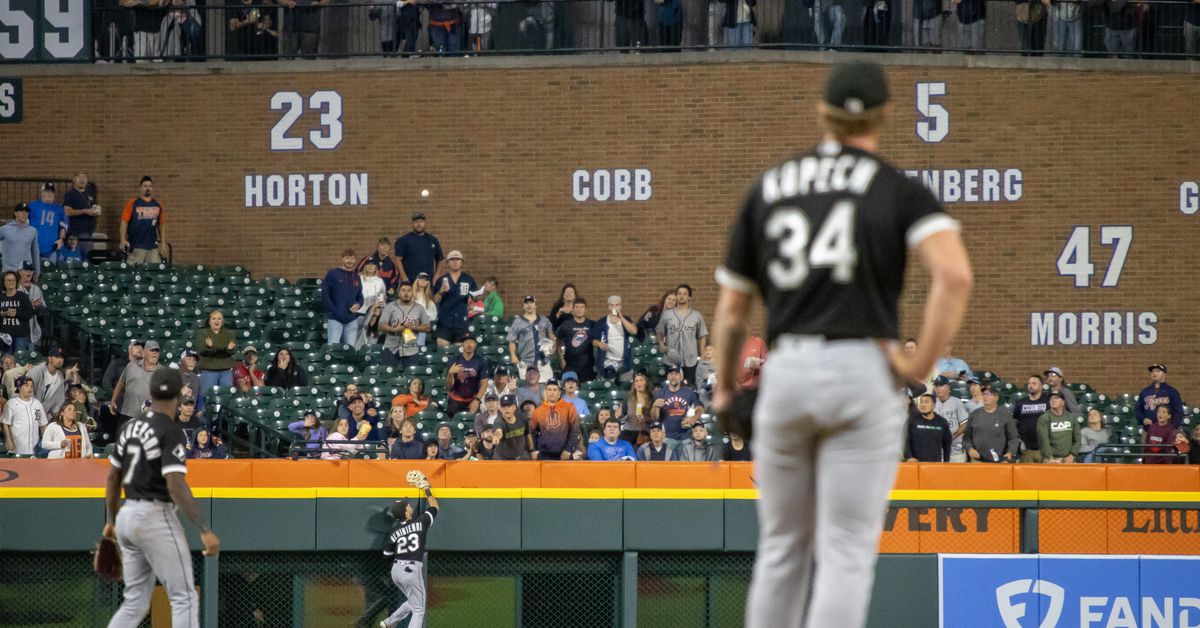It’s hard to believe that Michael Kopech has been in the White Sox organization for almost seven years now. His acquisition from Boston signaled the rebuild officially kicking off. Still, seven years later, he’s still an enigma.
Shortly after his major league debut in September 2018 Kopech underwent Tommy John surgery, and because of the involved rehab process followed by the pandemic in 2020, he didn’t throw another pitch until April 2021.
Resurging as a high-leverage bullpen arm for Tony La Russa’s 2021 squad — a role that allowed him to build up workload after the time lost — Kopech’s stuff was absolutely electric. That kind of production, albeit not in that exact role, was what fans were dreaming on back in December 2016.
The 2022 season was a mixed bag. Kopech woke up on June 8 with a 1.94 ERA and a 3.09 FIP that included shutting down both the Yankees and Dodgers offenses (13.0 IP, 0 ER, 14 K, 3 BB). He was never going to throw 180 innings that year, but getting good production over 120-130 innings was the plan — and that plan was on track two months into the season.
Kopech’s next start was June 12 in Chicago against the Rangers, and Kopech left the game in the first inning with right knee discomfort. His 14 starts after the injury, which the club did not feel warranted an IL stint, were not nearly as good. Kopech pitched to a 4.79 ERA and a 5.57 FIP with a 7% drop in strikeout rate. He did end up being placed on the injured list in late August to heal his knee, but actually finished the season with a shoulder injury that may have been an unintended consequence of favoring his knee.
At this time last year, the prevailing thought was that Kopech was still a very talented starter who struggled a bit physically to adjust to a typical starter’s workload — but no need to sound any alarm bells.
The issue that we’re here to analyze is that things got significantly worse in 2023, and Kopech was no healthier. What happened?
If Michael Kopech just didn’t seem as nasty in 2023 as he did in previous seasons, your observation would be correct. By referencing Stuff+, which for lack of a better description looks to quantify the “nastiness” of a pitcher and the respective pitches that he throws, Kopech’s Stuff+ was down across the board.
:no_upscale()/cdn.vox-cdn.com/uploads/chorus_asset/file/25061477/Screen_Shot_2023_11_06_at_3.46.31_AM.png)
Kopech had less raw spin on his fastball in 2023, and the most noticeable side effect was a steep (1.5´´) drop in its induced vertical break. However, while a vertical break drop like this is usually not desirable, the pitch’s vertical approach angle was actually slightly flatter (4.4 degrees to 4.3). Kopech, like Dylan Cease, had a longer release extension, and when you’re releasing the ball farther down the mound without an arm angle shift, your release height will drop and your vertical approach angle should be closer to zero — which is generally good.
Kopech’s results will point you to the fact that the vertical break drop is misleading; his fastball Whiff% was up from 25.5% in 2022 to 26.4% in 2023. The horizontal break on his fastball was also down about an inch, but he maintained his 71st-percentile velocity (95 mph). Long story short on this initial dissection: Kopech’s fastball stuff isn’t a major culprit here, even if it’s being disguised as one.
A much bigger problem is Kopech’s slider. The pitch had an inch-and-a-half less drop, which won’t tell you the whole story in a vacuum, but there was no coinciding increase in velocity and no evidence of a seam-shifted wake effect taking place. The slider did have more glove-side break in 2023 (4.7´´ to 5.5), but it was nowhere near the 9.2´´ of horizontal break that Kopech’s 2021 slider featured. That 2021 slider, paired with an arm-side running, upper-90s fastball, created a deadly combination that Kopech hasn’t been able to recreate as a starter.
Going back to that 2021 pitch arsenal, the slider that Kopech featured was much more “slurvey” (the modern term is probably “sweeper-ish”), meaning it was more of a slider/curveball blend. Heading into 2022 with Kopech transitioning back to a starting role, he needed a third pitch, and he didn’t (and still doesn’t) have much feel for a changeup. Thus, Kopech, pitching coach Ethan Katz, and the rest of the White Sox pitching development staff needed to split up that slurve into two distinct pitch shapes. If this sounds familiar, it’s because Dylan Cease needed to do exactly the same thing in the prior offseason, and it worked out magnificently for him.
One plan for 2024 could be to try an revert back to Kopech’s 2021 slider shape and effectively ditch the curveball; Kopech’s slurve created a nice spin-mirroring effect with his fastball (helping to create that aforementioned “deadly combo”). Then, with a need for at least a minor third-pitch offering, a low-90s cutter could work nicely. Kopech needs something to help neutralize left-handed hitters, who mashed to a .398 xwOBA (.428 vs. his fastball, .340 vs. his slider) against him in 2023.
Kopech’s command issues are also very evident. His overall Command+ was down four points in 2023, while his Pitching+ (a more comprehensive look at his pitch quality) was down six.
When Kopech threw strike one, he was an entirely different pitcher than when he didn’t.
:no_upscale()/cdn.vox-cdn.com/uploads/chorus_asset/file/25061478/Screen_Shot_2023_11_06_at_3.57.44_AM.png)
Aside from the work to be done to optimize his arsenal, the White Sox have to rethink what a Michael Kopech appearance looks like. It’s time to get creative, because there’s too many factors working against Kopech to continue to expect him to be a traditional starting pitcher. His pitch physics, injury history, lack of innings under his belt, and two years of contractual control remaining are all working against him.
Kopech has a 5.52 FIP in 52 starts over the last two seasons when deployed as a traditional starter. While many teams would take this information and simply deem that Kopech should move back to the bullpen, where he has shown the ability to have a ton of success, that would force the White Sox to sign four starting pitchers in free agency this offseason. Also, given that the team is not projected to be in playoff contention, the White Sox should be afforded the opportunity to experiment with Kopech’s usage — and that should be not as a starter, but also not necessarily as a reliever.
When Kopech’s rotation spot comes up every fifth day, the team should have him follow an opener, a concept that only a few teams around the league have regularly dabbled with. I’d like to see Kopech in a role that has him throwing between 50-70 pitches per outing that starts with him facing the bottom half of the order. When this plan works, the opener and Kopech cover between four and six innings, and then I would have Garrett Crochet, another tweener who I see as being good enough to cover more than a one inning relief role but not a traditional starter role, toss another 30-50 pitches as he builds up his workload.
In a best-care scenario, this trio could cover an entire game, but even if it doesn’t, it’s a more effective use of Kopech’s spot in the rotation. The hope is that when Kopech knows that he can empty his tank on 60 or so pitches, he stuff will play up. It’s not always that simple, but I don’t see much of a downside of the White Sox attempting an extremely progressive strategy for one of the rotation slots for the 2024 team. It’s a last-ditch effort to see if Kopech can be anything more than a one-inning reliever, while also getting a look at Crochet in an advanced role.
I like an opener ahead of Kopech, because I want to make his first time through the order easier. He struggled over the first couple of innings in 2023 before getting settled in.
:no_upscale()/cdn.vox-cdn.com/uploads/chorus_asset/file/25061479/Screen_Shot_2023_11_06_at_4.02.00_AM.png)
As you can see, Kopech should never face a third time through an order.
Another major issue for Kopech in 2023 that can’t be glossed over is the fact that he was very likely dealing with a balky knee through most of the summer. He had his right knee meniscus repaired in September, and if that knee feels better for 2024, it will only help him. My hybrid proposal for his 2024 role should help him ease back, and frankly, if Kopech is thriving in it, there’s nothing to say that Pedro Grifol couldn’t remove the theoretical 75-pitch cap in a given outing, or even remove the opener in front of him. The point is that Kopech can re-assert himself as your every-fifth-day, traditional starting pitcher by pitching really well — but let’s see it can be accomplished by cleaning some of the details in a more abbreviated role first.

